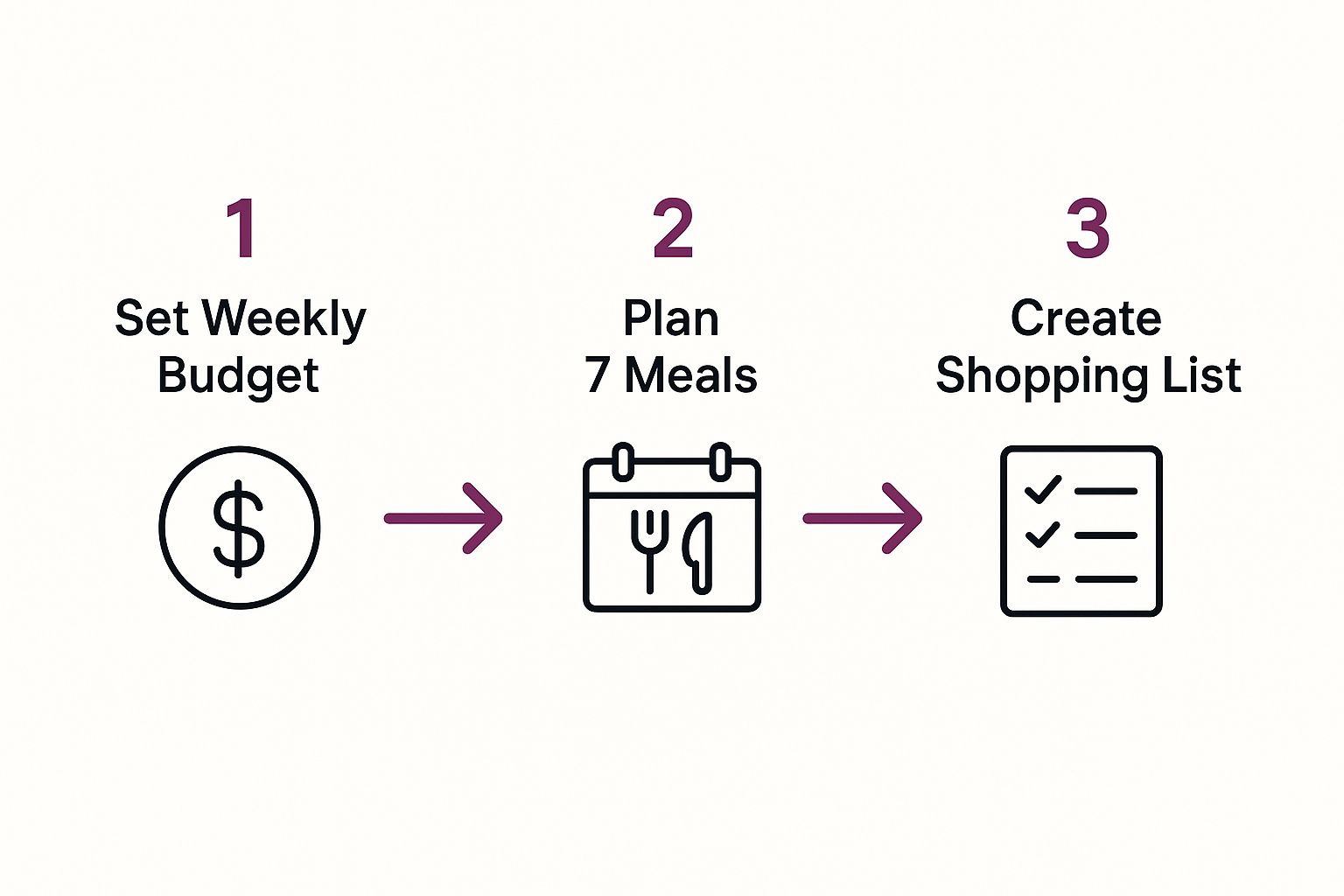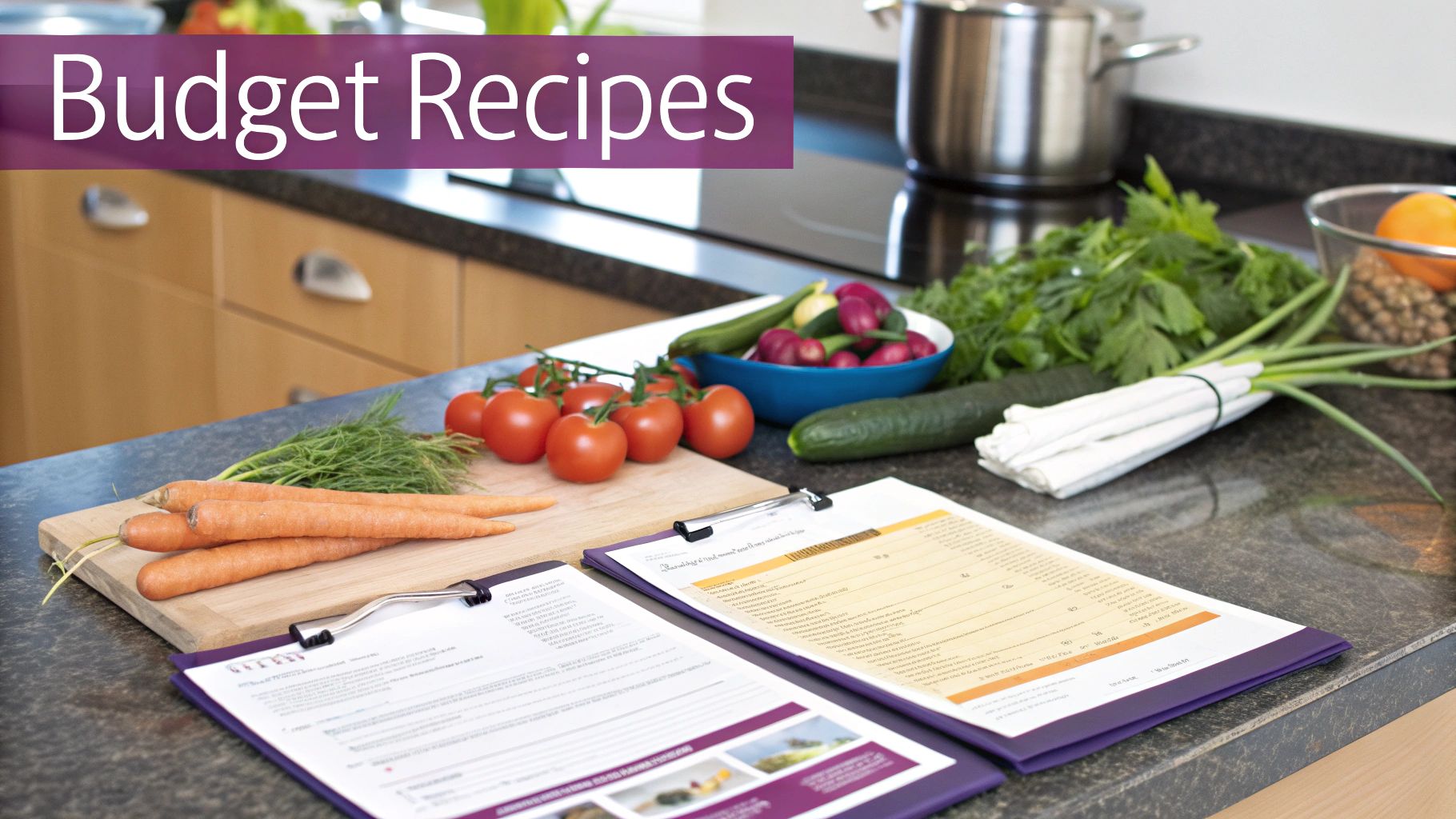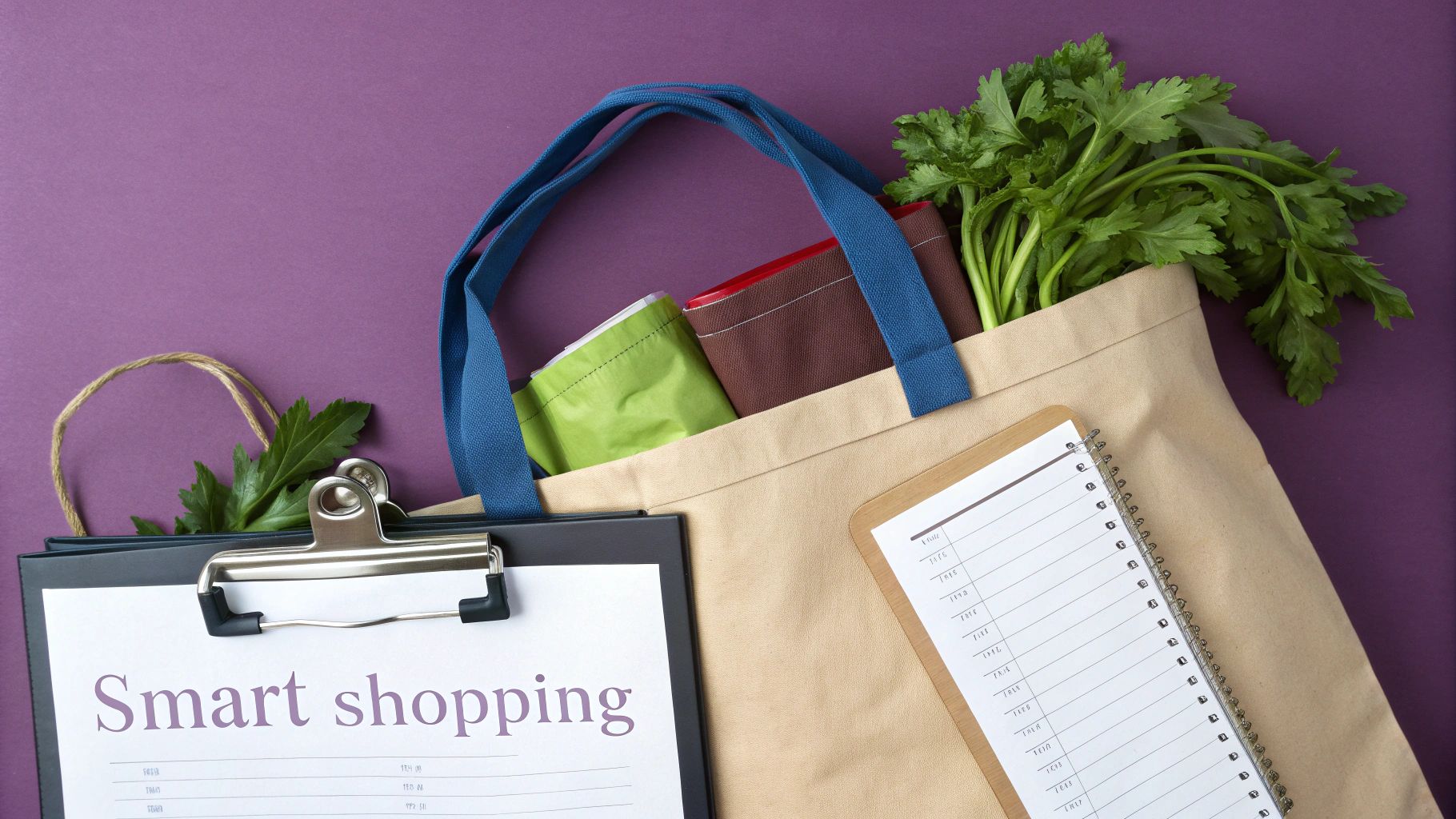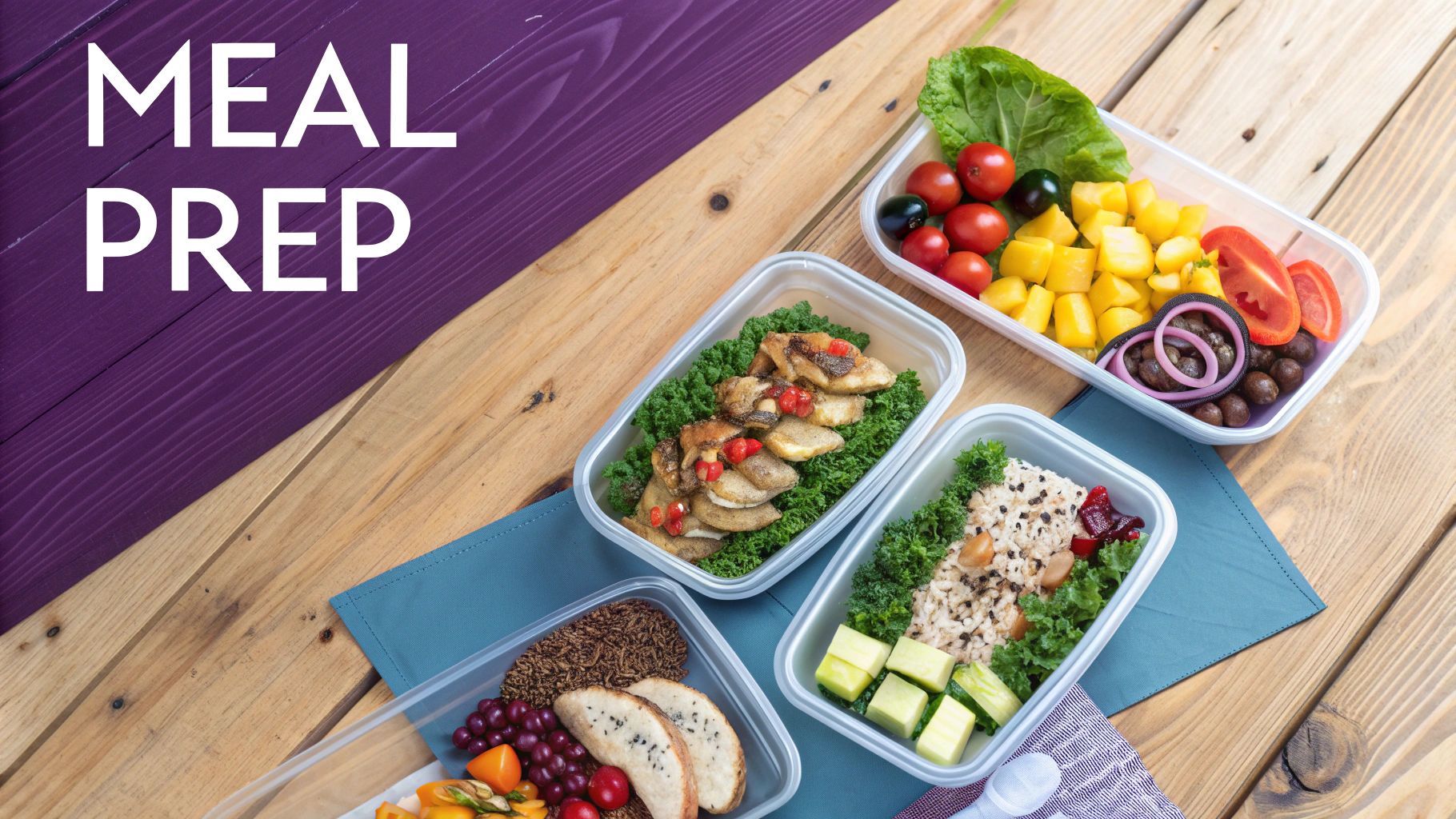
How to Meal Plan on a Budget That Works
Learning how to meal plan on a budget really boils down to three simple habits: take stock of what you have, map out a flexible meal framework, and build a grocery list based only on that plan.
This approach is your best defense against buying duplicates and making impulse buys. It's the foundation for a money-saving habit that will actually stick.
Your Foundation for Budget Meal Planning Success
Staring into an empty fridge when you're trying to save money is a uniquely stressful feeling. Breaking that cycle isn't about complicated spreadsheets or a rigid schedule you'll abandon in a week.
It's about building a simple, repeatable system. It all starts with a quick "pantry audit."
Before you think about what to buy, go on a scavenger hunt in your own kitchen. You’ll probably find half-used bags of rice, canned beans, or frozen veggies you forgot about.
Knowing your inventory is the single best way to stop buying things you don’t need.
This is the basic flow you'll follow—from setting your budget to creating a laser-focused shopping list.

Stick with this simple three-step process, and you'll find meal planning becomes a stress-free, core part of your routine.
Create a Flexible Framework
Forget mapping out a strict, unchangeable menu for every single day. Instead, think in terms of a flexible weekly framework.
Assign themes to certain nights, like "Meatless Monday," "Taco Tuesday," or "Pasta Night." This gives you direction without boxing you in.
This way, you can easily adapt to what's on sale at the store or use up ingredients you have on hand. If chicken thighs are a great deal, slot them into a "Stir-fry Thursday."
This flexibility is what makes a meal plan sustainable because it leaves room for leftovers and cravings.
Combine Your Fitness and Food Goals
A great meal plan doesn't just save you money—it also helps you hit your health goals. As you're sketching out your meals, think about how they line up with your exercise routine.
- Pre-Workout Meals: Plan for simple, carb-focused snacks or small meals. Something like oatmeal or a banana an hour or two before you work out gives you sustained energy.
- Post-Workout Recovery: After you exercise, your body needs protein and carbs to repair muscle. This is the time for meals like chicken and rice or a hearty lentil soup.
By connecting your diet and exercise, your budget-friendly meal plan becomes a powerful tool. For more great ideas on this, check out this video on what to eat before a workout from the @dietexercise youtube channel.
To get you started right away, here’s a quick-reference table. Think of it as your cheat sheet for putting these ideas into action today.
Your Quick-Start Budget Meal Planning Checklist
| Action | Why It Works | Simple Example |
|---|---|---|
| Shop Your Pantry First | Prevents buying items you already have on hand. | Check your freezer for forgotten veggies before adding more to your list. |
| Create Themed Nights | Provides structure without being overly rigid. | "Soup Sunday" or "Pasta Wednesday." |
| Build a List and Stick to It | The #1 defense against impulse buys and overspending. | If it's not on the list, it doesn't go in the cart. |
| Plan for Leftovers | Cooking once and eating twice saves time and money. | Make a big batch of chili and plan for chili-topped baked potatoes two days later. |
Taking these small steps consistently is what builds momentum. You don't have to overhaul everything overnight; just pick one action from the list and start there.
Turning Your Plan Into a Shopping List
Okay, you've got your meal ideas sketched out. Now comes the part that really makes or break your budget: the grocery list.
A well-thought-out list turns a chaotic shopping trip into a precise, money-saving mission. Without a list, it's easy to wander the aisles, grabbing whatever looks appealing.
That’s how you end up with a cart full of snacks and a big bill, but somehow still nothing for dinner on Wednesday.
Organize Your List Like a Pro
Here's a simple trick: organize your list by the store's layout. Group all your produce together, then dairy, then meat, then pantry items.
You'll move through the store efficiently instead of backtracking a dozen times. This little bit of organization does more than just save time.
It helps you dodge the tempting, high-priced items on those end-cap displays that are designed to derail your budget.
While you're at it, think about the nutritional bang for your buck. A good list helps you focus on nutrient-dense foods. If you're not sure what you're looking at on a package, our guide on how to read nutrition labels is a fantastic resource.
Build on a Foundation of Pantry Staples
Your pantry is your secret weapon for cheap and easy meals. When you have a solid stock of versatile ingredients, you can throw together a meal with just a few fresh items.
Think about stocking up on these essentials:
- Whole Grains: Things like oats, brown rice, and whole-wheat pasta are incredibly filling and cost just pennies per serving.
- Legumes: Canned or dried lentils, chickpeas, and black beans are powerhouses of plant-based protein and fiber.
- Canned Goods: Having canned tomatoes, corn, or tuna on hand means you're always ready to whip up a quick soup, sauce, or salad.
These items last for ages, so you can confidently buy them in bulk when they go on sale, knowing they won't go to waste. They provide a reliable base for your weekly meals.
Master the Art of the Sale
Getting serious about meal planning on a budget means becoming a student of food prices. The cost of fresh produce and meat can swing wildly from week to week.
Pay attention to weekly flyers and know what's in season. This allows you to build your meal plan around what's actually on sale, not just what you feel like eating.
This isn't just a nice-to-have skill; it's becoming essential. You can read more about these food price trends from the USDA to see why smart shopping is so critical.
When you spot a fantastic deal on a staple you use all the time—like chicken breast—that's the time to buy a few extra. This approach ensures you're consistently paying the lowest possible price.
Making Your Shopping and Meal Prep Work for You
Alright, you've got your killer grocery list. Now comes the fun part: hitting the store and turning that plan into delicious, money-saving meals.

Let's talk about bulk buying. For pantry staples that last forever—think rice, beans, pasta—going big can save you cash.
But apply that same thinking to fresh produce or dairy, and you're just buying a one-way ticket to food waste. And that's the fastest way to undo all your savings.
Become a Unit Price Pro
Forget the big, bright sale signs for a minute. The real secret to finding the best deal is the unit price.
Look closely at the shelf tag, and you'll see a smaller number that breaks down the cost per ounce, per pound, or per item. This is your key to a true comparison.
A giant tub of yogurt might look like a bargain next to two smaller ones, but a quick glance at the price per ounce might tell a completely different story.
The Magic of Batch Prepping
Once the groceries are home, spend an hour or two on a Sunday afternoon to prep for the week. This isn't about cooking five entire, separate meals. It's about batch prepping components.
Instead of a full meal, you're creating versatile building blocks.
- Grains: Cook up a big pot of quinoa or brown rice.
- Veggies: Roast a big sheet pan of whatever you like—broccoli, bell peppers, or sweet potatoes.
- Protein: Grill a family pack of chicken breasts, simmer a pot of lentils, or hard-boil a dozen eggs.
This simple strategy turns a stressful weeknight cooking session into a quick assembly job. After a workout, you can grab pre-cooked chicken and rice for a perfect recovery meal without any fuss.
Smart Storage Is Key to Less Waste
All your hard work is for nothing if your food goes bad. Poor storage is like literally throwing your money in the trash.
A good set of airtight containers is an absolute must. Glass is great because it doesn't stain or hold onto smells, and you can pop it right in the microwave.
For delicate stuff like lettuce, store it in a sealed container with a paper towel to soak up extra moisture.
Taking a little care here ensures your groceries actually end up on your plate. Our Durable Meal Prep Containers are designed specifically to keep your food fresh and neatly organized, making them the perfect partner for your budget meal plan. They are an essential tool for anyone serious about combining fitness goals with smart eating.
Delicious (and Genuinely Affordable) Meal Ideas
A budget meal plan is useless if you don't actually want to eat the food. The secret is building your menu around simple, satisfying ingredients that don't cost a fortune.

Learning to cook nutritious, budget-friendly meals is more than just a money-saving hack—it's a powerful life skill. This is especially true when you’re fueling an active lifestyle.
Your Go-To Budget-Friendly Recipes
Forget gourmet recipes with expensive, single-use ingredients. Master a few flexible meal "formulas" that you can change up based on what's on sale.
- Hearty Lentil Soups: Lentils are cheap, loaded with protein, and make an incredibly filling soup. Sauté some onion and garlic, toss in lentils with broth and canned tomatoes, and you have a fantastic meal.
- The "Everything" Stir-Fry: Got some veggies on the verge of going bad? Throw whatever you have into a pan with a simple sauce (soy sauce, ginger, and garlic) and serve it over rice.
- Versatile Grain Bowls: Cook a big batch of quinoa or brown rice. Each day, top it with different things—roasted veggies, chickpeas, and a simple dressing. They're perfect for meal prepping.
Think of these as your foundational recipes. For more inspiration, check out our guide on healthy lunch ideas for work.
Making Smart Protein Choices on a Budget
Protein is usually the most expensive item on the grocery list, but it doesn't have to drain your bank account.
It's time to think beyond pricey steaks and chicken breasts. Some of the best protein sources are also the cheapest. A dozen eggs can provide protein for multiple meals.
Here are a few budget-friendly powerhouses to stock up on:
- Eggs: The ultimate versatile protein. Scramble them for breakfast, hard-boil them for a snack, or fry one to put on top of a rice bowl.
- Beans and Lentils: Use them everywhere! They're perfect in soups, salads, and burritos, providing both fiber and protein.
- Tofu: This plant-based hero absorbs flavor, making it a fantastic addition to stir-fries, curries, and scrambles.
And for busy days or post-workout fuel, a quality protein powder supplement is incredibly cost-effective. It's an efficient way to support your fitness goals without splurging. Pairing your healthy eating with the right gear, like a shaker bottle for your supplements, is key. Our shop has exactly what you need to integrate nutrition and exercise seamlessly.
Stop Throwing Money in the Trash: How to Eliminate Food Waste
Every leftover you toss out is exactly the same as throwing cash directly into the garbage. Learning to meal plan on a budget is as much about using what you have as it is about shopping smartly.

This isn’t just about our own wallets; it's a global issue. If you want to dive deeper, the World Food Program has a great overview of the global impact of food security. Our habits in the kitchen might feel small, but they’re a real part of the solution.
Give Your Leftovers a Second Life
The biggest killer of leftovers is boredom. Stop thinking of leftovers as a repeat meal and start seeing them as ingredients for a new one.
Here are a few of my go-to transformations:
- Roasted Chicken: Shred any remaining meat for tacos, quesadillas, or a quick chicken noodle soup.
- Cooked Rice: Day-old, slightly dry rice is perfect for making fried rice. Toss it in a hot pan with frozen veggies, soy sauce, and a scrambled egg.
- Roasted Vegetables: Chop them up and add them to a frittata or omelet for an easy breakfast.
Use Every Single Part of Your Groceries
So many parts of vegetables that people automatically throw away are edible and packed with flavor. Adopting a "root-to-stem" cooking philosophy is about getting the most out of every single thing you buy.
Never toss out onion skins, carrot peels, or celery ends again. Keep a large bag in your freezer and add all your vegetable scraps to it. Once it's full, simmer them in a pot of water to create a free homemade broth.
Got some slightly wilted herbs or greens? For droopy greens like lettuce or kale, a 15-20 minute soak in a bowl of ice water usually brings them right back to life.
Pro Tip: A "first-in, first-out" system for your fridge is a game-changer. Whenever you buy new groceries, move the older items to the front so you use them first.
Pair Waste Reduction with Smart Fitness Fueling
Your efforts to reduce food waste can directly support your fitness goals. That leftover quinoa or chicken from dinner makes for an ideal post-workout meal. It gives your body the essential carbs and protein it needs for recovery without any extra cooking.
If you're looking to get your nutrition dialed in, the @dietexercise youtube channel has a fantastic video on how to eat for your fitness goals that I highly recommend. Proper nutrition requires the right tools, and our store offers everything from digital food scales to portion control plates, helping you precisely manage your intake to match your fitness output.
Got Questions About Budget Meal Planning? We've Got Answers.
Even the best-laid plans can hit a snag. Let's walk through some of the most common questions that pop up when you're getting the hang of meal planning on a budget.
A lot of people think meal planning is a massive time-suck, but that’s a myth. Once you find your rhythm, you can knock out a solid plan in just 20-30 minutes a week.
If you're just starting, don't try to plan every single meal. Just aim for three dinners for the week ahead and plan to use leftovers.
How Do I Meal Plan With Picky Eaters?
Navigating different tastes can feel like you're a short-order cook. The secret isn't to make three different meals, but to deconstruct them. Think "build-your-own" instead of a one-size-fits-all dish.
Taco night is the classic example for a reason—it works! This approach is a lifesaver for all kinds of meals:
- Pasta Bars: Cook one or two pasta shapes and offer a couple of different sauces.
- Grain Bowls: Start with a base of rice or quinoa, then set out different proteins and veggies.
- DIY Pizzas: Use pita bread or English muffins as a base and let everyone add their favorite toppings.
This method gives everyone a sense of control over their food. You get to stick to one simple, budget-friendly shopping list.
What if I Get Bored of Eating the Same Meals?
Budget meal planning isn't a sentence to eat bland chicken and rice forever. Meal plan fatigue is a real thing, but it’s totally avoidable.
My rule of thumb? Try to add one new, budget-friendly recipe every week or two. This slowly builds up your go-to list without blowing your grocery budget.
Don't underestimate the power of spices and sauces, either. A simple chicken and veggie stir-fry can taste completely different just by switching up the seasoning. This kind of small-scale variety is what keeps things interesting. To keep your fitness journey exciting, having comfortable and stylish activewear can make all the difference. Check out our apparel to find motivation for your next workout.
At Diet and Exercise, we believe that smart eating and an active lifestyle go hand-in-hand. To support you on your journey, we offer a full range of apparel and fitness accessories designed for every goal. Check out our collection and find the gear to complement your healthy new habits.
